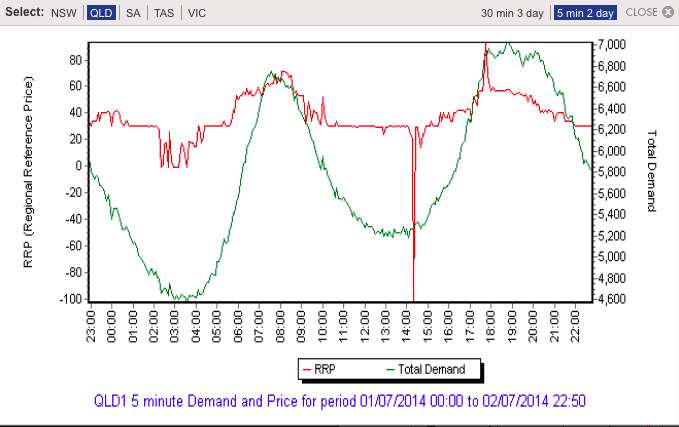The combination of low demand and strong output from the Queensland’s 1.1GW of rooftop solar helped send the state’s electricity prices into negative territory on Wednesday – in the middle of the day.
Daytime electricity prices have historically been the “cream” on the cake for electricity generators because that is when demand is usually the highest, and prices too.
But the emergence of rooftop solar as effectively the fourth largest generator in Queensland has changed the dynamics of the market, particularly on fine, sunny and warm winter days that have been experienced this week. Demand is weak because there are no air conditioners in use, electric heating is not required, and the sunny days means that solar output is strong.
As this graph above from the Australian Energy Market Operator shows, demand (the green line) in the middle of the day is plunging between the appliance-driven morning and evening peaks. At this time, the output of solar increased to around 60 per cent of its capacity (see below), accounting for more than 10 per cent of demand and sending out more than 600MW of capacity at certain times.
This situation has been exacerbated by restrictions on the interconnector with NSW, which means Queensland coal generators have been unable to send excess electricity to its southern neighbour, adding to the excess capacity in its own market.
As we reported yesterday, this has caused wholesale energy prices to plunge, highlighting the changing dynamics which are afflicting wholesale markets, and why fossil fuel generators want to slow or halt the progress of rooftop solar and other renewables.
On Tuesday this week, the wholesale price of electricity (in red in graph above) skirted around zero for several hours in the afternoon, and on Wednesday they plunged to minus $100/MWh at 2.20. (They were back at zero on Thursday morning between 11am and noon).
Negative pricing events are not unknown, but usually occur at night, when an excess of capacity and low demand in the early hours of the morning results in some generators willing to pay others to take their output rather than close down.
This has happened for years due to overbuilding of base load coal generators, but has become more frequent with the addition of more than 3GW of wind energy across the southern states.
A negative pricing event in the middle of the day is extremely rare. One trader in the market said he could not remember such an event. Bidding, however, has been confused and unpredictable because of the proposed repeal of the carbon price, which will be backdated if and when it happens.
As we explain here, some generators appear to be bidding into the market with a carbon price, and others not.










